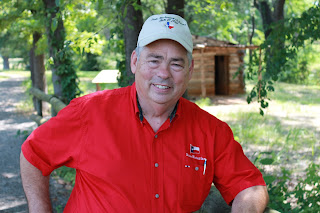"Lone Star Historian" is a blog about the travels and activities of the State Historian of Texas. Bill O'Neal was appointed to a two-year term by Gov. Rick Perry on August 22, 2012, at an impressive ceremony in the State Capitol. Bill is headquartered at Panola College (www.panola.edu) in Carthage, where he has taught since 1970. For more than 20 years Bill conducted the state's first Traveling Texas History class, a three-hour credit course which featured a 2,100-mile itinerary. In 2000 he was awarded a Piper Professorship, and in 2012 he received the Lifetime Achievement Award from the Wild West Historical Association. Bill has published over 40 books, almost half about Texas history subjects, and in 2007 he was named Best Living Non-Fiction Writer by True West Magazine.
 Established as a Confederate recruit camp four miles northeast of Tyler in 1862, Camp Ford was named after Col. John S. "Rip" Ford. In July 1863, following the fall of Vicksburg and Union seizure of the Mississippi River, federal prisoners of war were transferred to Camp Ford from confinement in Shreveport, Louisiana. At first there was no enclosure at the undeveloped encampment. Confederate guards supervised their prisoners in the open until November, when a stockade was erected around an area of about three acres. The water supply was a large spring inside the south wall. Prisoners built their own shelters from logs and brush and canvas. They also made small items - clay bowls, brooms, woven baskets, clothing - for personal use or for trade with local citizens for food.
Established as a Confederate recruit camp four miles northeast of Tyler in 1862, Camp Ford was named after Col. John S. "Rip" Ford. In July 1863, following the fall of Vicksburg and Union seizure of the Mississippi River, federal prisoners of war were transferred to Camp Ford from confinement in Shreveport, Louisiana. At first there was no enclosure at the undeveloped encampment. Confederate guards supervised their prisoners in the open until November, when a stockade was erected around an area of about three acres. The water supply was a large spring inside the south wall. Prisoners built their own shelters from logs and brush and canvas. They also made small items - clay bowls, brooms, woven baskets, clothing - for personal use or for trade with local citizens for food.  |
| Prisoner sketch of Camp Ford |
 |
| Dugout shelter completed with logs and a canvas roof. |
 |
| Lt. Col. J.B. Leake, ranking Union officer, sketched the cabin built for him near the spring, permitting an accurate reconstruction |
County Historical Society. I have been a member of the Camp Ford Historical Association for a number of years. On July 1, I revisited Camp Ford, where I met Joan Hallmark and camera man Phillip Stauts of Channel 7, KLTV in Tyler. Joan has interviewed me a number of times through the years about various books of mine that pertain to East Texas. Recently she learned of my appointment as State Historian, and she called me about taping a feature. I responded eagerly, because many Texans still are unaware that there is a State Historian. Joan conducted the interview with her customary charm and expertise. The two-minute feature will air on Channel 7 and 9 on Saturday, July 20, on the 10 PM Evening News. The feature will be shown again on Midday News at 11:30 AM on Thursday, July 25, and afterward it may be viewed on www.kltv.com.
For more information: http://smithcountyhistoricalsociety.org
http://www.48ovvi.org/oh48cf.html
http://ww.censusdiggins.com/prison_camp_ford.html




No comments:
Post a Comment